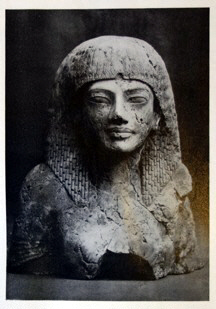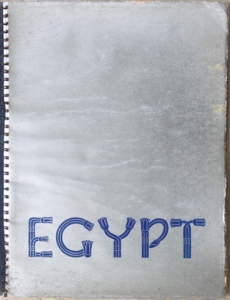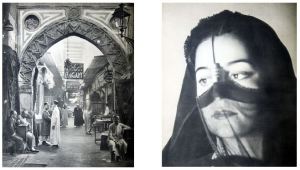
Recently, HV Morton Society member Tony Brett mentioned he had been researching into a small statue at the Birmingham Museum and Art Gallery. The full account of his search makes a gripping tale and Tony’s detective work would rival Hercules Poirot himself!
The story begins almost exactly a century ago…
On page sixteen of his excellent biography “In Search of HV Morton”, author Michael Bartholmew tells us about HVM’s eagerness to go on an assignment for the Daily Express, to report on the opening of the tomb of Tutankhamun, in 1923. The origins of this eagerness are, says Bartholomew, “… traceable to the Birmingham art gallery, where he was intrigued by a little statue”.
He quotes from Morton’s memoirs where Morton reports “My interest settled, for a reason I can offer no explanation, upon an ancient Egyptian bust about half the size of life which I took to be – indeed it may have been so labelled – a priestess of Isis… The work obsessed me and I began writing about it, trying to describe it, and in a moment of recklessness I posted one of these to… The Connoisseur… they printed the article and sent me a cheque for thirty shillings or two guineas. And then, of course, my fate had been cast. To realise while still at school that you can make money while writing is a most dangerous thing.”
Incredibly, it is this very statue that Tony has tracked down and, what is more, he has also managed to locate the article which Morton wrote for The Connoisseur magazine.
When Tony began his enquiries by contacting Birmingham Museum and Art Gallery, he was informed by Adam Jaffer (Curator of World Cultures) that the statue itself was most likely a piece known as the Limestone New Kingdom Bust donated to the museum in 1896. Adam told Tony two articles had been written about the bust, both in 1914.
The dates of the articles came as somewhat of a surprise to Tony, given Morton, born in 1892, had suggested in his memoirs he was at school when his was published. If one of these articles was actually Morton’s, this would make him a very late developer – still at school at the age of twenty two!
Undaunted, Tony set to work tracking down the relevant editions of The Connoisseur magazine. The Birmingham Library had, unfortunately, mislaid their copies in a recent move but they put him onto Birmingham University who in turn referred him to the Barber Institute who, at last, came up with the goods.

Tony got browsing and, sure enough, to his great relief, in the May 1914 edition he came across an article entitled “The ‘Monna Lisa’ of Ancient Egypt”, featuring a picture of the Limestone New Kingdom Bust – without question this was the article referred to in Morton’s memoirs!
Incedentally, by virtue of a little detective work of my own, I have discovered that the May 1914 edition of The Connoisseur is available online courtesy of the Internet Archive, here (Morton’s article is on page 27 of the pdf).
But what about the apparent discrepancy regarding Morton’s age when he wrote the article – just how long was HVM at school? Well, Morton’s memoirs were written towards the end of his life, while living in South Africa, and it is likely advancing years and possibly a little harmless artistic license accounted for this minor inaccuracy. It bears mentioning that the statue which, in his memoirs, is referred to as “a priestess of Isis”; was assumed by the younger Morton, in the original article, to be a representation of the goddess Isis herself.
The article is fascinating for a number of reasons in addition to being the original work which helped determine Morton’s future career. For one thing, it is certainly the earliest published work of HV Morton I have ever come across, but the Morton we know and love is there to be seen in his writing style, particularly his evocative and lavish descriptions.
The title of the article too, is interesting – the “Monna Lisa” of ancient Egypt. This isn’t a mistake; Morton is using the authentic Italian spelling of the title of Da Vinci’s work, to which he is comparing his ancient carving.
The thing that threw me completely for a while though was at the end of the article – the initials HCM. Had Tony fallen at the final hurdle I wondered; is this article even by Morton at all?
It is possibly because I am a veterinary surgeon that my confusion lasted as long as it did – the acronym HCM describes a particularly nasty heart condition suffered by cats! So I hope I can be excused for not realising at once that, although this wasn’t our familiar “HVM” (Henry Vollam Morton), it was the much less frequently (if ever) seen “HCM”, or Henry Canova Morton.
In an article by HV Morton’s niece, Jo Walters, she informs us Morton family legend holds that while Maggie, HVM’s mother, was expecting her first child in 1892, she bought some heather from a gypsy-woman. As she was leaving, the woman turned and said; “The child you carry is a boy, and if you call him ‘Canova’ he will be famous in one of the arts”.
Apparently HVM didn’t share his mother’s enthusiasm for the name Canova, (it came from a Venetian sculptor) and always said he did his best to keep it secret. But on this one occasion he has used it, albeit just the initial, and I don’t think anyone could deny that it did indeed help him on his way to becoming “famous in one of the arts”. Perhaps the prophecy of the gypsy lady was correct! Young Harry clearly wasn’t convinced however as, having this once appeased the fates, he thereafter dropped the “Canova” moniker in all future writings.
There is one, last point of interest about the article, not at all obvious from reading it, but which Tony has also uncovered in his researches. It turns out, the “Monna Lisa” of Ancient Egypt isn’t all she appears to be – that “weird smile”, which so entranced our young author, keeps a secret; one which, even to the end of his days, Morton remained blissfully unaware of. Read on to Part Two (below), where the secret is revealed!
§
“The ‘Monna Lisa’ of Ancient Egypt” part two… a Twist in the Tale
In which we discover that HV Morton has been labouring under a slight misapprehension!

Tony Brett first came across a possible reference to the statue, referred to by HVM as “The ‘Monna Lisa’ of Ancient Egypt“, when he wrote to Adam Jaffer for advice. Adam is Curator of World Cultures at Birmingham Museum and Art Gallery (BMAG) and clearly knows his onions because he recognised the statue from the brief description in Morton’s memoirs as being a piece known as the Limestone New Kingdom bust and so put Tony on the trail.
As a bit of background Adam kindly provided an article (sections of which can be seen below) written by Philip Watson – then principal curator in the Department of Human History – for “World Art”, a Birmingham Museum book published in 1999 and edited by Martin Ellis; a show-case for what BMAG considered their best pieces. This article proved most revealing:
§

EGYPT, NEW KINGDOM, LATE 18TH DYNASTY, 1400-1300 BC
Limestone Height 30cm (11 3/4 in.) Presented by Miss Hanson, 1896 (1896 A 69)
Despite being broken and unkindly treated by the ravages of time, this head is the finest piece of sculpture in Birmingham’s Egyptian collection. It is carved out of a hard limestone that unfortunately contained patches of softer rock, which have weathered away to produce the current pitted appearance. The piece was highly, polished and originally would doubtless have been painted, as was customary for Egyptian sculpture.
It was presented to the museum in 1896 and two accounts of the bust (both published in 1914) extol its charm and beauty. One of them calls it the “Mona Lisa of ancient Egypt” and interprets it as a bust of the goddess Isis. The unknown author is “astonished by her beauty“, comments on her “weird smile” and finally asserts that “all the beauty, all the mystery and all the culture of dynastic Thebes blossom on the lips of this strange, stone woman“…
Despite such eulogies, the head is, in fact, that of a man. The rather feminized breast is typical of Egyptian sculpture from the reign of Amenophis III, and the gracious, rather soft physiognomy recalls later eighteenth-dynasty statuary. The figure also wears a distinctly, male duplex wig; the top and back of the wig have wavy strands of hair tied into ringlets at the ends, and these seem to be superimposed over a second wig composed entirely of ringlets, which drop forward over the shoulders. This style is common in the late eighteenth dynasty… [PW]
§
So, wonderful detail about the statue and clear links to Morton’s Connoisseur magazine article, but unfortunately for HVM, and in spite of his reputaion as someone with an eye for the ladies, it turns out his “Monna Lisa” is a bloke!
In fairness, even looking again in the light of this information, the statue’s masculinity is far from obvious and, according to Watson, our man (the “unknown author” of the first 1914 article mentioned above) wasn’t the only one to have made the mistake.
In his memoirs, Morton was still referring to the statue as “she”, suggesting he probably went to his grave without realising his faux pas; but for us this footnote is an another entertaining facet of the life and works of Henry Canova Vollam Morton.
“World Art” is for sale in the Birmingham Museum shop and, although the Limestone New Kingdom Bust is currently “off display” (as the Egypt Gallery is closed due to building work for the new Staffordshire Hoard Gallery)*, it will be back on view once again in May, for all to enjoy.
I would like to express my thanks to Tony, on behalf of the HV Morton Society, for the tremendous job he has done in unearthing this early treasure to add to our archives.
Niall Taylor
*This item was originally circulated as HV Morton Literary Notes – No.123 parts 1 and 2, in March 2014









